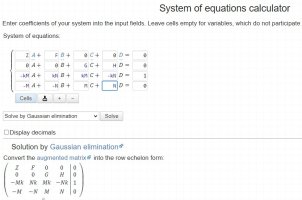Almost correct. The video put brackets to not lose track of the signs, but you did not put. Also, don't substitute [imath]s^{+}[/imath] and [imath]s^{-}[/imath] when you do the limit. Just substitute the letter [imath]s[/imath] without any signs.
You should write it like this:
[imath]Ae^{ka} + Be^{-ka} = 0[/imath]
[imath]Ce^{kb} + De^{-kb} = 0[/imath]
[imath]kCe^{ks} - kDe^{-ks} - (kAe^{ks} - kBe^{-ks}) = 1[/imath]
[imath]Ce^{ks} + De^{-ks} - (Ae^{ks} + Be^{-ks}) = 0[/imath]
After simplifying, we will get:
[imath]Ae^{ka} + Be^{-ka} = 0[/imath]
[imath]Ce^{kb} + De^{-kb} = 0[/imath]
[imath]kCe^{ks} - kDe^{-ks} - kAe^{ks} + kBe^{-ks} = 1[/imath]
[imath]Ce^{ks} + De^{-ks} - Ae^{ks} - Be^{-ks} = 0[/imath]
Now, you have 4 equations with 4 unknowns. It will be tedious to solve the equations by hand, so it is better to use a calculator. Before we solve these four equations, I will show a trick that can solve green function instantly. (almost instantly.)
I will go back to our green function solution:
[imath]\displaystyle G(x) =\begin{cases}Ae^{kx} + Be^{-kx} & \ \ \text{if} \ x < s\\Ce^{kx} + De^{-kx} & \ \ \text{if} \ x > s\end{cases} [/imath]
This solution can be written with hyperbolic functions like this:
[imath]\displaystyle G(x) =\begin{cases}A\sinh kx + B\cosh kx & \ \ \text{if} \ x < s\\C\sinh kx + D\cosh kx & \ \ \text{if} \ x > s\end{cases} [/imath]
I am lazy to use different constants, so I will use the same constants.
The trick will allow us to get rid of two constants which will make it very easy to find the remaining two constants.
Let us assume that [imath]A = 0[/imath] and let us apply the first boundary condition.
[imath]B\cosh ka = 0[/imath]
It is either [imath]B = 0[/imath] or [imath]\cosh ka = 0[/imath].
If you are familiar with the graph of the function [imath]\cosh x[/imath], you will know that it is impossible [imath]\cosh ka = 0[/imath], so it means that [imath]B = 0[/imath] which gives us the trivial solution [imath]G(x) = 0[/imath]. Our assumption was wrong.
Now let us assume that [imath]B = 0[/imath] and let us apply the first boundary condition again.
[imath]A\sinh ka = 0[/imath]
It is either [imath]A = 0[/imath] or [imath]\sinh ka = 0[/imath]. If [imath]A = 0[/imath], we will get the trivial solution [imath]G(x) = 0[/imath], so it must be [imath]\sinh ka = 0[/imath]. [imath]\sinh ka = 0[/imath] only when [imath]ka = 0[/imath]. We know [imath]k \neq 0[/imath], so it must be [imath]a = 0[/imath]. But this means that our interval will always start at zero. We want our interval to start at any number, not only zero. What should we do?
The solution is to introduce two new arbitrary constants. Let us write our solution so far.
[imath]\displaystyle G(x) =\begin{cases}A\sinh kx & \ \ \text{if} \ x < s\\C\sinh kx & \ \ \text{if} \ x > s\end{cases} [/imath]
We can write [imath]A\sinh kx[/imath] as:
[imath]\displaystyle \frac{A}{2}(e^{kx} - e^{-kx})[/imath]
Let us introduce our two new arbitrary constants, [imath]m[/imath] and [imath]n[/imath].
[imath]\displaystyle \frac{A}{2}(me^{kx} - ne^{-kx})[/imath]
Let us define [imath]\displaystyle m = e^{-ka}[/imath] and [imath]\displaystyle n = e^{ka}[/imath].
[imath]\displaystyle \frac{A}{2}(e^{-ka}e^{kx} - e^{ka}e^{-kx}) = \frac{A}{2}(e^{k[x-a]} - e^{-k[x - a]}) = A\sinh(x - a)[/imath].
A similar process will be done to [imath]C\sinh kx[/imath].
We are allowed to introduce any arbitrary constants and define them with our choice as long as the main conditions are satisfied.
Our new and enhanced solution is now:
[imath]\displaystyle G(x) =\begin{cases}A\sinh(k[x-a]) & \ \ \text{if} \ x < s\\C\sinh(k[b - x]) & \ \ \text{if} \ x > s\end{cases} [/imath]
Now the boundary conditions are satisfied and we were able to get rid of two constants. Also we are free to choose any interval.
Let us apply green function properties:
[imath]-Ck\cosh(k[b - s]) - Ak\cosh(k[s - a]) = 1[/imath]
[imath]A\sinh(k[s - a]) = C\sinh(k[b - s])[/imath]
Can you find the constants [imath]A[/imath] and [imath]C[/imath]?


